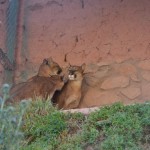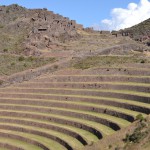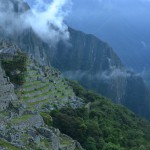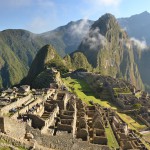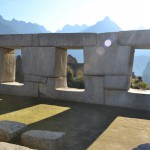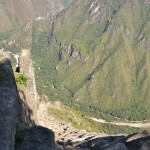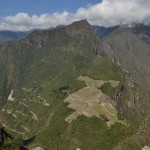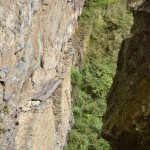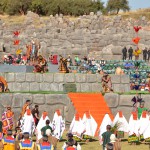From Puno, we took the last segment of our Bolivia Hop bus ticket to go up to Cuzco – this was an all-day bus trip with some nice scenery on the way. Arriving in Cuzco, we were pleasantly surprised: While the town is the hop-off point for many international tourists who want to see Machu Picchu, the town itself is very nice too. It used to be the Inca capital, and while today the historic center is dominated by Spanish colonial palaces and churches, many of them are actually built on Inca foundations – you can oft can see the Spanish adobe bricks sitting on top of the Inca rocks in the outside walls of colonial buildings.
Another great thing about Cuzco was the food. Of course, many restaurants are somewhat touristy, but the food was still so delicious and fresh in all of the restaurants we went to – even in some small holes in the wall where we were the only guests! Peruvians simply must know how to cook – no wonder Peruvian cuisine has become such a dominant force on the continent. We got to try some traditional Peruvian dishes as well, including alpaca meat (which was delicious).
On 21 June, we left for a two-day tour of the Inca sights in the nearby sacred valley and Machu Picchu. The sacred valley runs east-west and therefore is aligned with the Milky Way, which made it sacred for the Inca civilization who put great importance on astronomy. The Inca sites in the valley have mostly been destroyed by the Spanish and you can mostly see the foundations made out of humongous rocks. The Inca were slightly crazy in how they built cities – a lot of the time on the tops of steep mountains, using rocks of hundred tons of more that they moved to the construction site from many kilometers away over mountains and through valleys – all without having any advanced technology, they didn’t even know the wheel!
After a short night in Aguas Calientes, the small town / tourist trap which is at the foot of Machu Picchu mountain, we went up to Machu Picchu before sunrise. The site Machu Picchu was not known to the Spanish, since it had been abandoned for unknown reasons, and was only rediscovered in 1911. Therefore, in contrast to the other Inca sites, this one is in great condition. No gold or silver was found in the town, but the houses, temples and terraces are still in great condition. Especially considering that Machu Picchu was a small town compared to for example Cuzco, the engineering capabilities of the Inca are really impressive. The fact that they built these massive sites on the tops of steep mountains is just mind-boggling.
Visiting Machu Picchu was really an amazing experience. Even though there are of course quite a few other tourists around, it wasn’t nearly as crowded as we had feared. Especially in the morning, when the thick clouds of the night were still wafting through the mountains and the big tour groups had not arrived yet, the place really had a mystical feel to it. I won’t describe all the sights in Machu Picchu – there are books who do a better job of that, and I will include some pictures instead. In addition to the main site of Machu Picchu, we also climbed the neighboring mountain Huayna Picchu, which towers 360m over Machu Picchu. Going up was a steep and strenuous one-hour hike/climb, but the views from up top were great (not for those who are afraid of heights though since there are steep cliffs in all directions). The crazy Incas even built temples and houses on top of this mountain! After about seven hours of exploring Machu Picchu, we went back to Aguas Calientes, and then via train back to Cuzco for a couple more days.
Another highlight that we got to experience in Cuzco was the Inti Raymi festival, which was going on all of the days we were there and peaked in a celebration in the Inca site of Sacsaywaman on a hill overlooking the city. Inti Raymi is the Inca celebration of the new year, which coincides with the summer solstice. The celebration was banned by the Spanish as pagan and anti-catholic, and only resurrected in 1944 to celebrate the Peruvian / Quechua heritage. Today, it is a huge spectacle with thousands of costumed people dancing and parading in the streets for days, and one of the biggest festivals in South America. In addition to witnessing the parties in the streets, we also had bought tickets to the main ceremony in Sacsaywaman. This celebration recreates the Inca new year ceremony, including the different tribes coming to pay their tribute to the Inca (which means “king”, the civilization should rather be called Quechua civilization), as well as sacrifices of various goods including a llama, whose heart is then ripped out to read the omens for the new year. We read before that they no longer use a real llama for this offering, but they certainly did a good job at making it look real! Also, the whole ceremony including dances and songs by probably a thousand or so costumed performers in front of the background of the Inca sight were very impressive, so we were glad we got to see this! And while the tickets for the seats, mostly occupied by tourists, were quite expensive, there were also heaps of locals who flocked to the hills around the square to watch the ceremony.
We left Cuzco on 25 June to go to Lima.
Some pictures follow.
- Pumas in the wildlife sanctuary
- Sacred Valley
- Inca terraces
- Machu Picchu in the morning mist
- Machu Picchu
- Temple of the three windows
- Stairs down from Huayna Picchu
- View from Huayna Picchu down on Machu Picchu
- Inca bridge
- Inti Raymi
